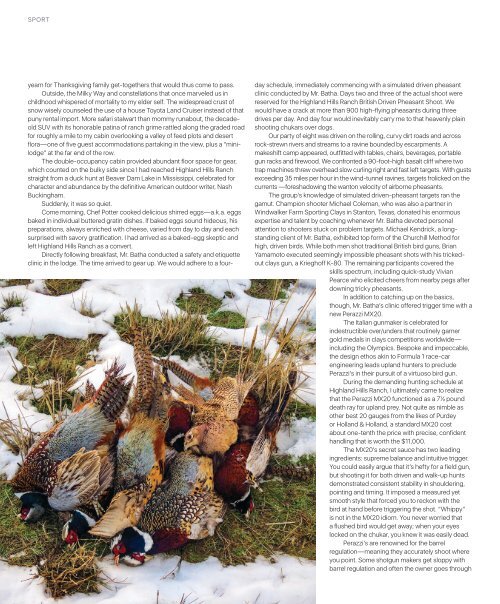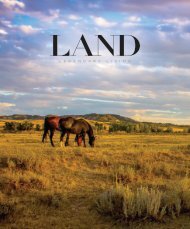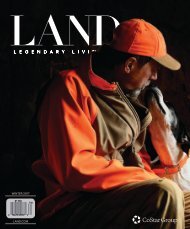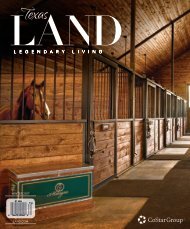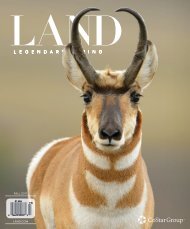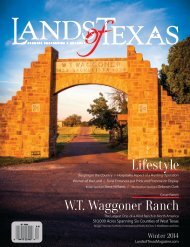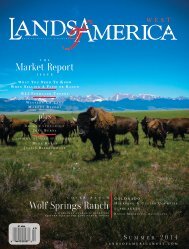You also want an ePaper? Increase the reach of your titles
YUMPU automatically turns print PDFs into web optimized ePapers that Google loves.
SPORT<br />
yearn for Thanksgiving family get-togethers that would thus come to pass.<br />
Outside, the Milky Way and constellations that once marveled us in<br />
childhood whispered of mortality to my elder self. The widespread crust of<br />
snow wisely counseled the use of a house Toyota Land Cruiser instead of that<br />
puny rental import. More safari stalwart than mommy runabout, the decadeold<br />
SUV with its honorable patina of ranch grime rattled along the graded road<br />
for roughly a mile to my cabin overlooking a valley of feed plots and desert<br />
flora—one of five guest accommodations partaking in the view, plus a “minilodge”<br />
at the far end of the row.<br />
The double-occupancy cabin provided abundant floor space for gear,<br />
which counted on the bulky side since I had reached Highland Hills Ranch<br />
straight from a duck hunt at Beaver Dam Lake in Mississippi, celebrated for<br />
character and abundance by the definitive American outdoor writer, Nash<br />
Buckingham.<br />
Suddenly, it was so quiet.<br />
Come morning, Chef Potter cooked delicious shirred eggs—a.k.a. eggs<br />
baked in individual buttered gratin dishes. If baked eggs sound hideous, his<br />
preparations, always enriched with cheese, varied from day to day and each<br />
surprised with savory gratification. I had arrived as a baked-egg skeptic and<br />
left Highland Hills Ranch as a convert.<br />
Directly following breakfast, Mr. Batha conducted a safety and etiquette<br />
clinic in the lodge. The time arrived to gear up. We would adhere to a fourday<br />
schedule, immediately commencing with a simulated driven pheasant<br />
clinic conducted by Mr. Batha. Days two and three of the actual shoot were<br />
reserved for the Highland Hills Ranch British Driven Pheasant Shoot. We<br />
would have a crack at more than 900 high-flying pheasants during three<br />
drives per day. And day four would inevitably carry me to that heavenly plain<br />
shooting chukars over dogs.<br />
Our party of eight was driven on the rolling, curvy dirt roads and across<br />
rock-strewn rivers and streams to a ravine bounded by escarpments. A<br />
makeshift camp appeared, outfitted with tables, chairs, beverages, portable<br />
gun racks and firewood. We confronted a 90-foot-high basalt cliff where two<br />
trap machines threw overhead slow curling right and fast left targets. With gusts<br />
exceeding 35 miles per hour in the wind-tunnel ravines, targets frolicked on the<br />
currents —foreshadowing the wanton velocity of airborne pheasants.<br />
The group’s knowledge of simulated driven-pheasant targets ran the<br />
gamut. Champion shooter Michael Coleman, who was also a partner in<br />
Windwalker Farm Sporting Clays in Stanton, Texas, donated his enormous<br />
expertise and talent by coaching whenever Mr. Batha devoted personal<br />
attention to shooters stuck on problem targets. Michael Kendrick, a longstanding<br />
client of Mr. Batha, exhibited top form of the Churchill Method for<br />
high, driven birds. While both men shot traditional British bird guns, Brian<br />
Yamamoto executed seemingly impossible pheasant shots with his trickedout<br />
clays gun, a Krieghoff K-80. The remaining participants covered the<br />
skills spectrum, including quick-study Vivian<br />
Pearce who elicited cheers from nearby pegs after<br />
downing tricky pheasants.<br />
In addition to catching up on the basics,<br />
though, Mr. Batha’s clinic offered trigger time with a<br />
new Perazzi MX20.<br />
The Italian gunmaker is celebrated for<br />
indestructible over/unders that routinely garner<br />
gold medals in clays competitions worldwide—<br />
including the Olympics. Bespoke and impeccable,<br />
the design ethos akin to Formula 1 race-car<br />
engineering leads upland hunters to preclude<br />
Perazzi’s in their pursuit of a virtuoso bird gun.<br />
During the demanding hunting schedule at<br />
Highland Hills Ranch, I ultimately came to realize<br />
that the Perazzi MX20 functioned as a 7½ pound<br />
death ray for upland prey. Not quite as nimble as<br />
other best 20 gauges from the likes of Purdey<br />
or Holland & Holland, a standard MX20 cost<br />
about one-tenth the price with precise, confident<br />
handling that is worth the $11,000.<br />
The MX20’s secret sauce has two leading<br />
ingredients: supreme balance and intuitive trigger.<br />
You could easily argue that it’s hefty for a field gun,<br />
but shooting it for both driven and walk-up hunts<br />
demonstrated consistent stability in shouldering,<br />
pointing and timing. It imposed a measured yet<br />
smooth style that forced you to reckon with the<br />
bird at hand before triggering the shot. “Whippy”<br />
is not in the MX20 idiom. You never worried that<br />
a flushed bird would get away; when your eyes<br />
locked on the chukar, you knew it was easily dead.<br />
Perazzi’s are renowned for the barrel<br />
regulation—meaning they accurately shoot where<br />
you point. Some shotgun makers get sloppy with<br />
barrel regulation and often the owner goes through<br />
78


